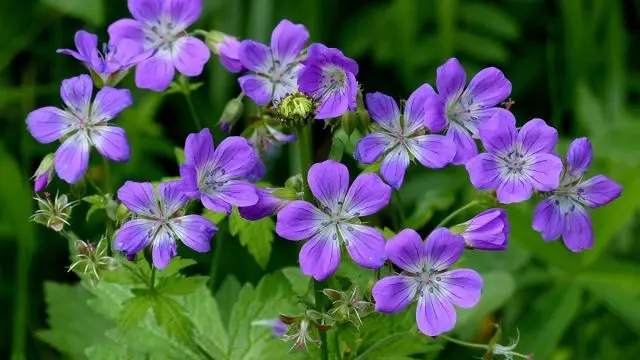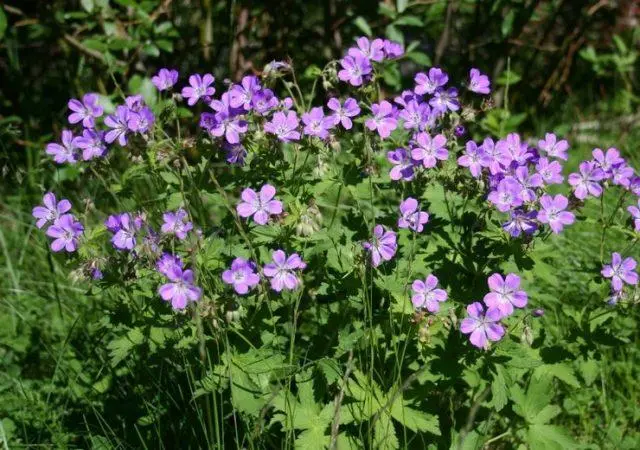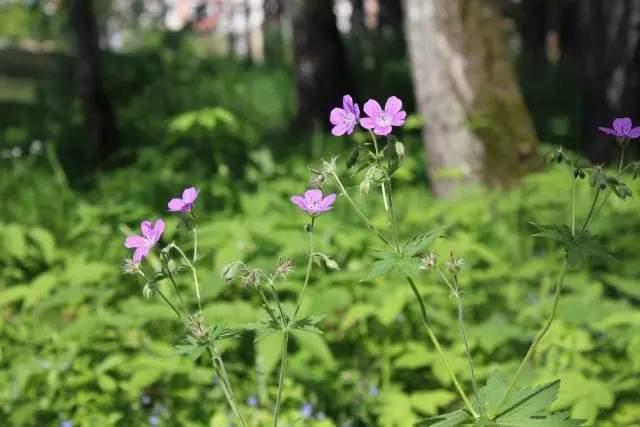Contents
Forest geranium (Geranium sylvaticum) is a herbaceous perennial crop that is most often found in shady areas of deciduous forest. All parts of this plant contain a lot of useful elements and are successfully used by people for medicinal purposes. But, like any other herb, in addition to benefits, it can also cause harm, which is why you should consult a specialist before using products prepared on its basis.

Since ancient times, forest geranium has been used in folk medicine.
Description of forest geranium
Forest geranium is a perennial of the geranium family, the height of which is usually 25-60 cm, less often 80 cm. The stems of the plant are bearded, straight, slightly branched from above, there are not very many of them on the bush. In the lower part they have adpressed hairs, in the upper part there is a glandular pubescence. The leaves of the forest geranium, located at the roots, are pinnately incised, petiolate, can be five- or seven-parted. Those that are in the central part of the stems are five-parted, smaller, their petioles are short. The upper leaf plates are almost sessile, tripartite, opposite. The rhizome of the plant is thick, but short, up to 10 cm in length. Usually it is vertical, but sometimes it can be oblique, wider in the upper part. Flowering of forest geranium is observed already in spring, in May, and continues until the end of June or the second half of July. It is quite abundant, the buds are large, collected in loose two-flowered inflorescences, open wide. Their color is predominantly purple or lilac, sometimes it can be pink, less often white. After the end of the budding period, fruits are formed in place of the inflorescences, they are softly pubescent, in appearance similar to a bird’s beak.
Due to the essential oils that make up the culture, it has a sharp, memorable smell, although wild varieties are less fragrant compared to indoor counterparts. The strongest incense is emitted by Robert’s geranium (robertinum), popularly referred to as stinker.
Where grows
Geranium or forest pelargonium prefers to grow on rich, slightly acidic, clay, sandy or silty soil. In nature, it is found mainly in areas with a temperate and cold climate, in mixed and light coniferous forests, in meadows, edges, among shrubs. Forest geranium grows in the European part of the Arctic, in Ukraine, in Moldova. On the territory of the Federation, it is massively found in Western and Eastern Siberia, in all regions of the North Caucasus.

In different regions, forest geranium may be called differently.
poisonous or not
Pelargonium is a harmless plant that does not contain poisons, although in some cases it can harm. For example, it is dangerous for asthmatics and allergy sufferers to contact it, as it can provoke coughing attacks, as well as rashes and tearing.
Medicinal properties of forest geranium
Due to the presence of nutrients, forest geranium has medicinal properties. It synthesizes tannins, essential oils, acids, carbohydrates, alkaloids. The green mass of the plant contains vitamin C, glucose, fructose, flavonoids, seeds have antioxidant properties. Many trace elements were found in the vegetative mass, and starch and organic acids were found in the roots.
During the flowering period, forest geranium is often harvested, dried and then used as a medicinal raw material.
Traditional healers share many recipes for a variety of culture-based decoctions, rubs, and infusions that are commonly used externally. They reduce pain from bruises and sprains, soothe itching, and effectively stop bleeding from cuts and wounds. Infusions and decoctions of forest geranium help to quickly cure sore throats: pharyngitis, tonsillitis, tonsillitis, they are also used as an aid in the treatment of gastrointestinal diseases, to get rid of diarrhea, enterocolitis, dysentery.

Almost all varieties of culture have medicinal properties.
Indications and contraindications
Forest geranium is indicated for use as a disinfectant, antibacterial, pain reliever. It has astringent properties, it is used for rinsing the mouth with stomatitis and various inflammations. An infusion of its aerial parts helps with kidney stones, rheumatism, gout, angina pectoris. Compresses and baths from forest geranium are used to get rid of boils, purulent wounds, and to treat hemorrhoids. With the help of decoctions, they get rid of indigestion, they are also used as a hemostatic agent.
Contraindications to the use of drugs from forest geraniums:
- idiosyncrasy;
- pregnancy and the period of breastfeeding;
- children up to 14 years;
- thrombophlebitis;
- exacerbation of diseases of the gastrointestinal tract;
- varicose veins.
Methods of Use
With diarrhea, osteochondrosis, rheumatism, salt deposition, a decoction of pelargonium is used. To prepare it, take the crushed roots of the plant (20 g) or dry grass (60 g), pour the raw materials with cold water 200 and 500 ml, respectively, boil over low heat for a quarter of an hour, drink 2-3 sips throughout the day.
For gargling and external use, an infusion prepared according to the following recipe is used: dilute 1 tsp in a glass of water. dry raw materials, boil for 15 minutes, insist under the lid for an hour, strain.
Instead of a decoction, it is allowed to use a cold infusion of geranium: pour 60 g of dry leaves of the plant into 500 ml of boiled water, leave for 12 hours. Take 100 ml three times a day.
Conclusion
Forest geranium is a perennial that is found throughout almost the entire territory of Our Country, with the exception of the Far East. This plant can be seen in forests, on the edges, in bushes. It is quite easy to recognize and almost impossible to confuse with other herbs. Forest geranium is not used in ornamental cultivation; traditional healers usually collect it for the preparation of medicinal potions.









